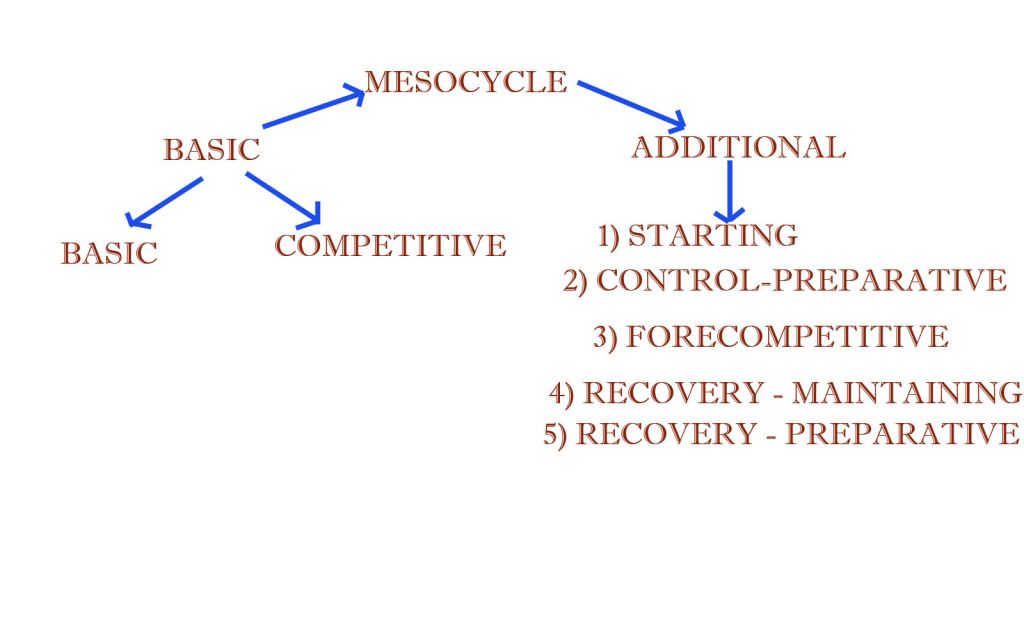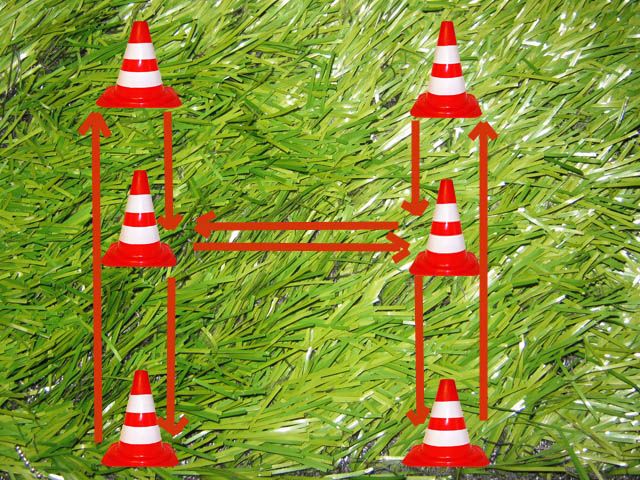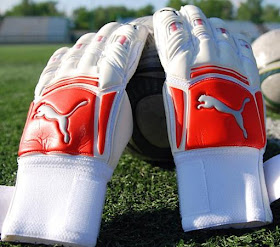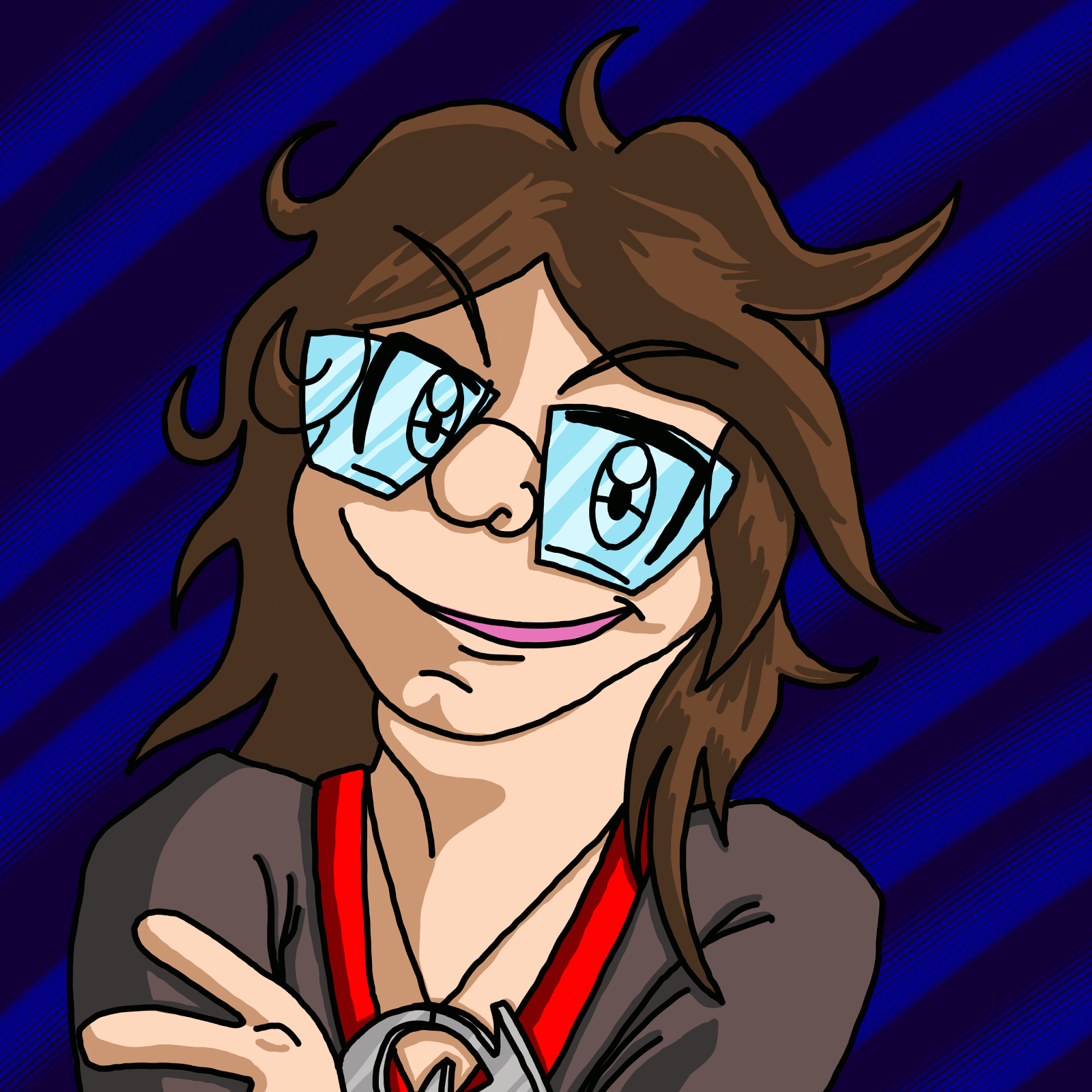Mesocycle is the medium training cycle contained of
more smaller training units – microcycles. In it can be at least 2 microcycles, with minimal lasting of 15 days,
and the most 6-7 microcycles that last maximum 45 days. Most of authors say
that the most popular are mesocycles that contain 4 microcycles and last around
one month. So some people say wrong – month cycles.
In mesocycles is build training process
coordinated with main goal and assignments of period, phase or stage of
preparation; enables optimum load dynamics and relation of methods and
resources, and also rational regime of training influences, that stimulate
adaptation on training conditions(but contain fatique at athletes) and recovery
processes. This is saying that
mesocycles are determined partially with same factors and circumstances like
microcycles. However, that is not enough to explain the goal of medium cycles,
cause they are not simple sum of microcycles. Basic factors that determine
mesocycle structure are:
1) Necessity
of enabling cumulative training effect,
2) Specificity
of adaptative reactions on load,
3) Priority
goals and assignments in development of
sportsmen abilities,
4) Training
content,
5) Competition calendar features – competition number and character,
6) Length
of intervals among competitions,
7) Features
of sports preparation in various periods of macrocycles,
8) Recovery
conditions,
9) Biorhythmic
factors.
Basic factor due to which mesocycle has to be
accepted as necessary shape in which training process is built is management
of cumulative training effect that is created as the consequence of microcycles
series. These way will satisfy two goals. First, wished flow of
athlete’s training development is enabled, cause it is related to whole,
summary load, load specificity and other, related to this, relatively longer
period of time. Second, violation of adaptative processes that threatens in
conditions of chronic fatique is stopped.
Regulation of effort and recovery in microcycle
borders is not sufficient, cause it has to be regulated in mesocycle as a whole
unit. For example, after hitting microcycle athlete needs to be recovered,
which means that in these microcycle it will come to variation of load size. This
variation has wavy dynamics(huge loads – small loads), and wave size is medium
compared to complete training structure. Medium load waves are some of
typical features of training mesocycle.
In mesocycle microcycles of various direction
are applied. Some microcycles are directed to trainness improvement(physical,
technical, tactical…), others to integral preparation, third to recovery etc.
Along with that, summary load in various microcycles can vary in wider limits.
Following microcycles can be applied in four possible cases:
1) In
the situation of complete recovery from effort in previous microcycle.
2) In
the situation of increased physical work capacity,
3) In
the situation of visible, emphasized fatique,
4) In
the situation of first signs of overtrainness.
In fourth case microcycle that occurs has to be
recovery microcycle. In other cases
various diagnose can be applied.
In work with top athletes and athletes of high
training level, in modern sport is viewed tendency to sum microcycle loads that
enter the composition of mesocycle, by going through the way of fatique progression from one into the other
microcycle. These type of training requires maximal mobilization of all
organism reserves and adaptation to extreme difficult training conditions.
That is the “impact” not only on physical, but to psychological component of a
human. If this type of work is forced into the longer period of time – that is
the road to overtrainness. Athlete needs to be rest, to enable adaptation
processes to attain applied loads. After more hard cycles, it is needed to do
recovery microcycle and that is the only correct road to enable wished training
effect. This type of approach would be wrong with younger athletes, and
multiply dangerous also. Situations 1) and 2) are more better.
If loads in hitting microcycles were bigger,
loads in recovery microcycles are smaller. If lasting of huge efforts is
longer, recovery microcycle will be longer.
There are few types of mesocycles, that are
separated by lasting and content, and also have various place in macrocycle.
All mesocycles can be divided into two groups. First group is basic, and other
group is additional mesocycles.
Basic mesocycles are featured for training
periods in macrocycle. Into these mesocycles are counted basic and competitive
mesocycle. Basic mesocycles are
basic in preparatory period, and competitive
in competitive period of training. The essence of preparatory period is to
create basis for successful competition in competitive period, so names of
these mesocycles originate from there.
In basic
mesocycle is done basic work on creating preconditions for competition.
The fundament is built through development of basic and specific athlete’s
ablities. Dependant of which devices dominate in mesocycle, basic or specific,
basic mesocycles are divided into basic-preparatory and specific-preparatory.
First and other type of basic mesocycle can contain huge amount of load, and
also influent variously on training dynamics. Loads can be usual, in limits of
reached adaptation level. Athlete organism, in that case, doesn’t have
stimulus for adaptation on higher level, but with usual size of applied load it
is stabilized. Due to that, this type of basic mesocycle is called stabilizing.
It is featured not only by decrease in load size, but also with load and
training method variabilities.
Bigger loads, that ask for determined adaptation
period, influent positively on further development of athlete trainness.
Mesocycle in which summary big loads are applied are developing mesocycles. In
its structure key place is reserved for hitting microcycles of various type.
There are more different possibilities of ordering microcycles in developing
basic mesocycle. Usually mesocycle contains of 1-2 hitting microcycles, between
which normal microcycles can exist. Developing basic is, by rule, ended with
recovery microcycle. At
significantly emphasized fatique, after very big loads, recovery microcycle is
not enough for recovery. After that stabilizing basic mesocycle will go, which
isn’t last long, cause these are usually two normal microcycles.
Training programs in basic mesocycle are
featured not only by huge summary volumes and training intensities, but also by
more often appliance of single training with big load. Instead of it, here is possible big
variability in the choice of devices and methods for development of physical,
technical, tactical and psychological abilities.
In all types of basic mesocycles, basic
elements are training microcycles of various type. Recovery microcycles are usually common part of these
cycles, while in its structure competitive and starting microcycles can be found
very often. That is the case with specific competition calendar when there are
competitions in preparatory period that are first in the season, and result is
important. This example are cup competitions in soccer and basketball.
Competitive
mesocycle in basic type of
mesocycle, which structure, content and number in macrocycle mostly depends on
sports branch or discipline specificity, macrocycle type in which mesocycle is
found and number of competitive periods inside of it, competition calendar features
and athlete’s sports level.
In competitive mesocycle intensive training
work is done, whose assignment is to lead the athlete to the level of maximal
abilities for performance on competition. It is cleared that it can only occur
in the terms of complete functional recovery, by which it comes after optimal
varying of load size, appliance of proper devices and recovery methods along
with their rational combining with tonizing training, medical-biological and
psychological devices. That is
the way to navigate the process of sports form, in which athlete has to be
inside competitive mesocycle.
Competitive
mesocycles can be mutually very various, not only in different, but in the same
sports branches and disciplines. Differences are specially emphasized in the
lasting, structure and content of specific mesocycles. As an example, various
mesocycles can be mentioned in all sports branches in which competitions are
held, that are different by lasting, regime, system and content.
In the structure of competitive mesocycle
competitive microcycles are dominant, that follow each other. Before the first
competitive microcycle in a row, or instead of more important competition in
mesocycle, starting microcycle can occur. After hard competitions, or after the
series of competitive microcycles, recovery microcycle occurs.
Additional
mesocycles are featured for
specific phases of training process. Here are counted following mesocycles:
starting, control-preparative, forecompetitive,
recovery-preparating and recovery- maintaining.
Starting
mesocycle is the first
middle cycle of the season. This is reserved to start preparative period, and
that determines features of the period. Basic goal is to “enter” the athlete
into the season and prepare him for huge efforts that occur in next mesocycles
of preparative period. Size of load in starting mesocycle is smaller related to
basic mesocycles of the season. Loads are small, especially on the account of
training intensity, while shape can be bigger, especially in sports branches for
which endurance is the most important feature. Endurance is lightly
increasing in the starting mesocycle. It is about start of the season, so
preparative drills dominate. Motoric and functional abilities that influent to
the efficiency of next trainings are increased. It is mostly about increase
in aerobic capacities, basic strength,
speed and flexibility. In this cycle, in the beginning of the season,
technic-tactic repertoire can be widespread, especially if preparative period
lasts longer, and if it is worked about younger athletes.
In normal circumstances, starting mesocycle
lasts 15-20 training days and contains 2-3 normal microcycles, and, in the end
of microcycle, recovery microcycle. It can also last longer or be repeated in
the case that the athlete had a longer break from various reasons(mostly
injury) or if the athlete was very passive in the transition period. In team sports, it can be programmed only for
one member if there are proper reasons.
Name on
itself control-preparative period
leads to its essence – control of reached prepareness level and further
preparation. Sometimes it is called also preparative-control mesocycle, by
emphasizing preparation component in its content. Control in this cycle
means determination of training level and athlete or team sports form, that is
done by previous work. This control has integral character, cause competitive
drills are applied, and through competitions athletes are not only controlled,
but also prepared further, to perfection. Except of competitive drills,
specific-preparative drills are applied that are, by specificity, very close.
Sometimes is needed to emphasize preparation through specific training drills,
and sometimes to decrease level of load, if signs of general fatique appeared.
Other access emphasizes competitions inside of cycle. First access is good if
preparation period lasts longer, and other leads to its shorter lasting when it
has to be hurried to enter the condition of sports form.
If
preparation period lasts shorter, then there is no space for this type of
mesocycle. Exception are top athletes that have full season and less needs for
basic mesocycles. Related to their high training level, competitions in the
border of control-preparative mesocycle are the most efficient device of fast
entering into sports form, especially if competitive period starts with
important competitions. However, control-preparative mesocycle doesn’t occur
before competitive mesocycle. Through control on competitions, necessary view
into integral prepareness will be obtained. That leads to correction in the
next mesocycle, that is usually forecompetitive.
Structure of control-preparative mesocycle is
created of training and competitive microcycles. Due to that, there is an
accordance among theoretics of sports training that these mesocycle is
transition type that is found between basic and competitive.
Forecompetitive
mesocycle is typical for
the stage of immediate preparation for the main competition or one of the main
competitions. It would be wrong to ask for its place only in preparation
period. Here is created preparation for the main competition, so it can be in
the end of preparation period(if season starts with some important competition)
or in competitive period in front of the main competitions.
In preparation period forecompetitive mesocycle
is logically supervened to control-preparative mesocycle. In it all misses in
trainness spotted into previous cycle should be corrected. Misses, if worked
regularly, shouldn’t be more significantly emphasized. That means that enough
time stays till the beginning of competition to remove them and to work, most
of all, on tactic and psychological preparation for the competition. Generally, loads should be increased in
specific work, but take care about timely relieve, for efficient development of
adaptative changes and necessary “freshness” with which it should be accessed
to the competition.
In forecompetitive period adaptation of an
athlete to concrete competition terms should be enabled, so this type of mesocycles has model
character. Its basic sign is that athlete is adequately prepared for successful
competition. Related with that, it is necessary to model:
a) exercises
b) relation
of various training resources
c) size
and load dynamics
d) competition
regime
e) “outer”
competition terms
Basic
principle in work is: maximal closing of training process to competition
conditions.
Competitive
drills by its features should
be on the level of expected on competition, and above that too. In any case,
they shouldn’t overwhelm earlier level reached. Specificity of training process
should be increased during cycle. On the other side, temporary appliance of
contrast trainings, non-specific by its direction, is necessary. Number of
these trainings, like praxa shew, shouldn’t be big and should be avoided in the
last 5-7 days of mesocycle. That is significant change related to primary
ideas of appliance “principle of the pendulum”.
Schedule of load size can be various, which in
great measure depends on trainings in previous mesocycle. If previous mesocycle
was featured by significant volumes, than in forecompetitive period should
gradually, from week to week, decrease volume, and increase load intensity.
Smaller volumes in previous mesocycle ask for wavy volume variation so the
microcycle of bigger volume is changed with microcycles of smaller volume. In
competitive period, when till the beginning of forecompetitive mesocycle were
more competitions and when fatique of them is visible, in first microcycle
athlete has to be refreshed, partially change devices, sometimes change the
place of training etc. In the next microcycle load size and training
specificity is increased. In all written variants, last microcycle has to be
smaller load(for adaptation), but through significant decrease in volume, and
maintain high, competitive specific work intensity.
Modeling of competitions regime in training is
significant part of total modeling in forecompetitive mesocycle. It gathers load order, change of effort and
rest on competitions that last longer and on which at least two times is a game
or match, competition days regime etc.
All that is said is related to “internal”
factors and competition conditions. Good
preparation asks modeling of “outer” factors and conditions, cause they can
have significant influence on sports result. On preparation competitions is
needed to create conditions of main competition, preparing competition should
be maintained in the conditions of surround and on the way how it will occur on
main competition(climate and geographic conditions, judging conditions,
space conditions, sport object and equipment features…). The biggest problem for coach is to prognose and model psychological
conditions of competition. Conditions can be changed by influences from
the inside, in athlete on himself, and out of the athlete, and can vary pretty
widely.
In the preparation for extremely important, the
most important competitions, not only season, but macrocycle, and often the
whole carriere, like Olympic Games, in final preparation two mesocycles of
forecompetitive type can be connected.
Structure of forecompetitive mesocycle is
featured by competitive microcycles of model type and training microcycles. In
some variants these two types can be combined.
Recovery-preparative mesocycle is typical for intrastages that
are found between two competitive periods, but it can also be applied in terms
of longer competitive period lasting(around 5 months) when it is not possible
to maintain the athlete in the condition of sports form. In modern training
praxa, in many sports branches and disciplines, more and more is avoided one
longer competitive period of longer lasting and due to that during one year we
meet two or three competitive periods. In the brakes between them, if last 20+
days, recovery-preparative mesocycle is applied. From its name is seen
direction of this cycle – recovery and preparation. It is needed to recover the
athlete from previous efforts, then to renew the base of its preparation and
through specific work to regain sports form.
Structure of recovery-preparative mesocycle
should have features of “small
preparation period”. In the beginning the athlete rests, most often
passively, dependant on the size of fatique in the previous period. After that
devices are chosen and methods of active recovery and development of general
abilities. Next microcycle should be tonizing with the content in which
dominate specific-preparative drills. Only one type is written. Types of
structure of these mesocycles type depends on:
1) Intrastage
lasting,
2) Features
of previous competitive period,
3) Degree
and character of athlete fatique,
4) Degree
of an athlete trainness,
5) Sports
calendar features,
6) Significance
of first competitions in the following competitive period,
7) Required
“speed” of reentering into the stage of sports form and other.
Recovery
– maintaining cycle asks
whole transition period if it lasts short. According to that, it could be the
basic type of mesocycle. However, significance and lasting of transition periodare significantly smaller from other training periods, so it is counted in
additional mesocycles. In this type of medium cycles athlete recovers not
only from competitive period, but also from the whole previous season. Recovery is active with the main assignment
to maintain abilities on determined level. This mesocycle, depending on
numerous factors, can be differently built. In any case, in it dominate
unloading and training basic-preparative microcycles, but in various variants
can be determined other types of microcycles instead of competitive.













